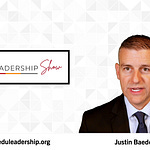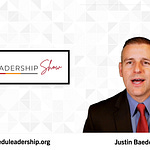Sold A Story Episode 13: The List (on EdReports, Success For All, and Steubenville, OH)
My kingdom for a reliable curriculum review, by Holly Korbey
The “Just Tell Them” Trap, by David Didau
Just Tell Them: The Power of Explanations and Explicit Teaching, with Zach Groshell on Principal Center Radio
Full Transcript:
(00:01):
Welcome to the Eduleadership Show. I’m your host, Justin Baeder, and in this episode we’ll talk about curriculum reviews and what we need from them. We will talk about the, just tell them trap and some considerations about teacher talk and student talk when we’re using explicit instruction. And we’ll talk about what happened when teachers brought their own chairs to professional development. Let’s get to it.
First up, let’s talk about curriculum reviews and the organizations that provide them. Journalist Holly Korbey has a new article that I want to share some insights from that echoes something that you may have heard in a recent update to the Sold A Story podcast by Emily Hanford. If you heard Emily’s recent updates on the Steubenville School District, you might’ve heard her talk about how the curriculum that they’re using from Success for All is not on the list or was not on the list of Ed Reports, a major nonprofit that provides curriculum reviews.
(01:11):
And that episode got some of the national conversation going on curriculum review organizations. But Holly Korbey has done an in-depth article on curriculum review called My Kingdom for a Reliable Review, where she explains what the different types of curriculum reviews do and what we need them to do. And one occasion for her looking into this and talking about it is that the CEO of Ed reports one of the major organizations and the one that declined to initially put Success for All on its list, their CEO is departing in 2026. And Holly wonders if perhaps there is a sea change coming, a new opportunity to improve curriculum reviews. But take a look at some of what Holly says in her article over at the Bell Ringer. She says, reviews are only produced by groups of educators and no researchers or experts are consulted. And reading and math programs that use techniques unsupported by research have received the coveted green light, while others that have been proven successful often through randomized controlled trials have not creating confusion.
(02:15):
And what she’s talking about here is, of course, success for all, which has been proven to be highly effective through randomized controlled trials, as well as other approaches. And the reason that those approaches have not made it onto the list of ED reports is that Ed Reports is looking at one particular thing. Holly says, ed Reports is mainly looking at Common Core alignment. And of course, that’s not the only thing that we may be concerned with. But there are other reviewing organizations such as the Federal What Works Clearinghouse, which she says they do efficacy reviews of curricula. And the What Works Clearinghouse database is interesting because what they also look at is the quality of the evidence itself, not just the quality of the programs that are studied. They look at the quality of the studies. The Knowledge Matters campaign is also looking at knowledge building.
(03:04):
And the Reading League tool evaluates evidence-based reading materials. And some of their concerns include whether students have the opportunity to read whole books. And I’ve been engaging with this issue lately and looking into what the different components of a good curriculum need to be. And I think there is some legitimacy to the idea that students do need to be reading whole books. They do need to be building knowledge systematically. And right now we don’t have one organization that can provide all of the types of information we need when reviewing curriculum. And if we make a list of all those different issues, they are standards alignment again, which is what Ed Reports does with the Common Core standards. They look at does this curriculum cover what it needs to cover? Second, is there evidence that the curriculum works? And this is outside of the scope of ED reports.
(03:49):
You can have an entirely new and unproven curriculum that gets the green light from Ed Reports, even if it doesn’t have any evidence of efficacy. And I can see the point there that people should be able to come up with new standards aligned curriculum and get it to be tried in schools. We shouldn’t have to prove that something works before anybody is allowed to use it. But at the same time, we do have mounting evidence about specific programs and we should make decisions based on that evidence. And the third criterion is the quality of evidence. Now, there’s a little bit of potential for confusion here because sometimes the evidence itself can be very high in quality. A study done by researchers on a curriculum can itself be of high quality, but the curriculum that it’s studying may not actually work very well. This high quality study may demonstrate that a curriculum is in fact mediocre and has almost no impact.
(04:40):
Fourth, we can look at whole Books and fifth, Knowledge Building. And I have to say personally, my kids have really benefited from a knowledge building curriculum wit and Wisdom in elementary school. And I think anytime we’re not taking advantage of the opportunities that we naturally have in school to systematically build students’ knowledge, they’re not going to be as effective. Students are just not going to have the opportunities they have to learn and to develop the schema and the background knowledge that they need to read at high levels and go on to advanced study. So let me know what you are looking for in curriculum reviews.
(05:12):
I think one final point that Holly makes that’s worth mentioning is that we do need organizations that are dedicated to this. We simply do not have time. Policy makers don’t have time. District decision makers don’t have time to review every single curriculum and every piece of evidence about it. There needs to be a coordinated kind of FDA style clearinghouse for this type of research about curriculum and evidence about curriculum. But let me know what you think.
(05:35):
Next up, in a new article called the Just Tell Them Trap British educator, David Didau takes a little bit of an issue with the title of Zach Groshell’s book. Just tell them to make what I think are some very good points. He has in the subtitle of his article, how Direct Instruction Gets Mistranslated as Teacher Talk lecturing and all sorts of other dull bobbins. And he’s referring here to Zach Rochelle’s excellent book. Just tell them the power of explanations and explicit teaching, which you can learn about on Principal Center Radio. We’ll put a link to my interview with Zach Rochelle in the show notes. But this is a great book on explicit instruction. But David’s argument in his article is that the fact that explicit instruction is a good thing does not mean that teachers should simply talk all the time.
(06:25):
And that may be obvious to us, but in reality, people hear things like just tell them and get in the habit of just telling kids stuff and not getting them to do anything. And I think there are two critical distinctions here in David’s article, and then I’ll share a couple of quotes from David. The first distinction that Zach Rochelle points out in his book is that explicit instruction is far more effective than what we might think of as constructivist or discovery learning, right? If we want students to know something, to understand something, to be able to do something, it is far more effective to explicitly teach them how to do that and to get clear on what we want them to learn and figure out the best way to teach it, to explain it, to model it, to help them practice. Explicit instruction is not even close, far more powerful than any kind of discovery learning.
(07:14):
However, that doesn’t mean that the proper role of the student in explicit instruction is passive. Students need to be active. And this is much of what David talks about in his article, that students need to constantly be doing something other than just listening. So explicit instruction cannot just be the teacher talking and the students listening. David says, fully guided instruction is not monologue, but dialogue. It’s structured interaction. Teachers explain model, question, check, and adapt in response to what students show. They understand. Effective teachers design a high ratio of participation constantly assessing attention and comprehension and holding students to account for the quality of their thought. So yes, tell them. Tell them clearly. Tell them well tell them again, but don’t just tell them. Make them think, speak, write, and argue. If the purpose of explanation isn’t to expand students’ thoughts so they can think the unthinkable and the not yet thought, then it results in an impoverished classroom experience. So check out that article over on David’s website and let me know what you think.
(08:19):
Lastly, I wanted to share a video from TikTok user, Abby Schnieders, who caption this video when the staff decides to bring their own chairs to PD without telling admin, take a look, return to the Mac up.
(08:34):
What it’s looking for, a better way to get up, getting on the internet and checking new of somewhere between y’all walking here is a party been, and we did it. Music I my skin, and put my bones into everything I record to that stage, light on down. Got that game, my style money sucks. Stay on my and stick around for those. Do trust me. And so 14.
(09:12):
So a lot of fun can be had when teachers bring their creativity to things like this. And I’ve seen PD sessions where teachers brought their own camping chairs and a campfire and grass carpet, lots of fun that could be had here. But there are also some serious points made in the comments over on Abby’s TikTok. One teacher said, I was 34 weeks pregnant with twins, and we had a full day of PD sitting in the cafeteria tables. I dragged a comfy chair in from the student lounge, so I wouldn’t die of pain. And another teacher says, because why are we expected to sit on bleachers for hours with no back support? Sorry, but we are not children. And I can also attest to the challenge of sitting in chairs that are made for children, especially if they’re made for kindergartners or first graders. Look, the reality is adults need adult seating.
(10:00):
They need chairs that are a little bit padded that have back rests, not the cafeteria tables or benches or bleachers that just don’t have any back support. And honestly, metal folding chairs are not good enough either. I think we need to make people comfortable enough that they can actually pay attention and not have the seating be a distraction. And a sofa may be the way to go. A beanbag may be the way to go. I’m not sure about that. I personally need to kind of sit up at a table to not get too sleepy. But let me know what you think about, bring your own chair. That’s it for this episode of The Eduleadership Show. I’m Justin Baeder, and I’ll see you next time.










